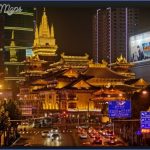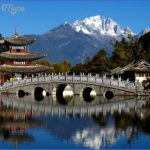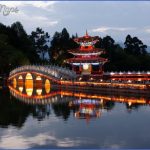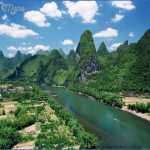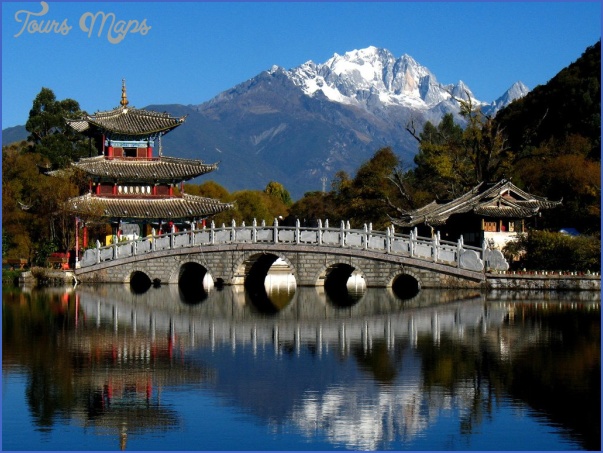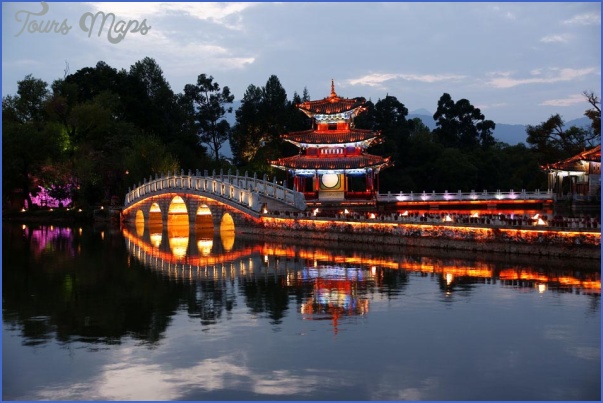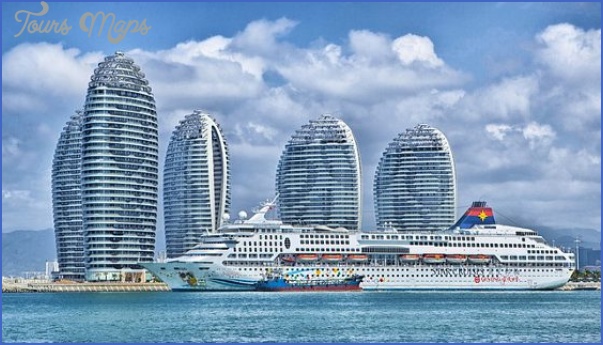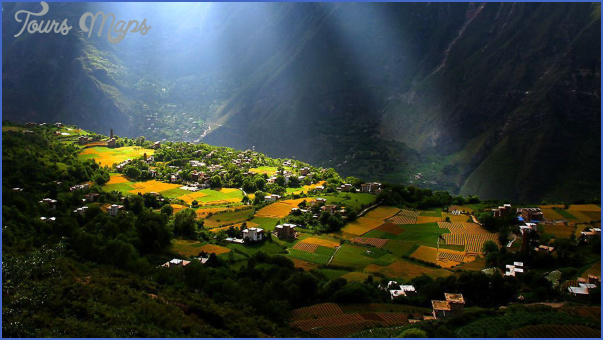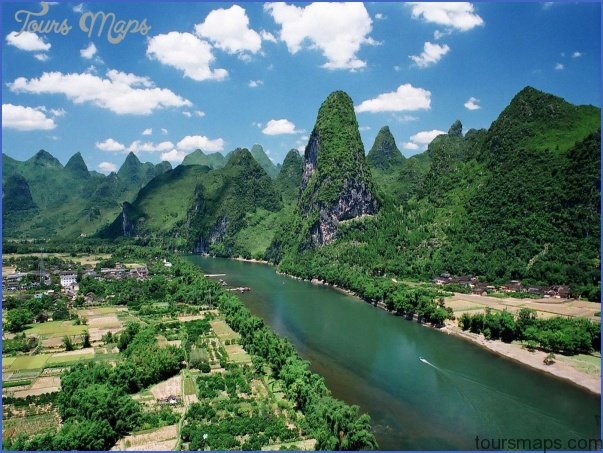The People’s Republic of China has become an in place to visit. Even the Love Boat made the trip in 1983. China is hurrying to build the facilities needed to attract more tourists. In 1981, 670,000 tourists other than Chinese from Hong Kong made the trip. Japan supplies the largest number of visitors to China, followed by the United States, France, and Germany. The number of Americans who arrived in 1981 was estimated at seventy thousand. More than seven million ethnic Chinese from abroad visited in 1982.
Most visitors enter China via eighty-nine miles of track linking the Hong Kong border with Canton’s Kwangchow stations. Train passengers transfer at Lo Wu and walk across a covered bridge to board the Canton train at Samchun.
From Canton an express train runs north to Shanghai. The trip takes eight hours. As with Russian rail service, two types of train accommodations can be had, hard and soft. Hard means berths without bedding and no carpets on the floor. Soft gets the traveler made-up beds in compartments. Another train from Lo Wu heads north on a thirty-six hour trip to Beijing (Peking).
The Shanghai Express, a train with a history, runs between Shanghai and Beijing. The nine-hundred-mile trip takes twenty-two-and-a-half hours. China’s Luxingshe is the official state tourist organization for looking after foreign visitors.
Visitors to China, like those to Russia, are much impressed by the trip but do not find it entertaining or particularly comfortable. In the summer parts of China get very hot and air conditioning is scarce. Air conditioning in some of the airplanes consists of the traveler being handed a popsicle and a fan.
In China, rent a car and you also get a driver. No driver, no car. Car use fits the chauffeur’s schedule, 8:00 a.m. to noon, two hours for lunch, then 2:00 p.m. to 6:00 p.m. Schedule changes, however, can be arranged.
Steam locomotives are still around. In fact, a factory in Mainland China continues to make them.
The overwhelming impression of China by outsiders is that of tens of millions of people people everywhere, people walking, people riding bicycles, part of the total population of one billion.
China has four major tourist attractions: the Forbidden City, the Great Wall, the hundreds of clay soldiers at Xian and the Grand Canal, the ancient one-thousand-mile water route connecting Beijing with Hangzhow near Shanghai. The Canal was built by hand twelve hundred years ago. It is said that some 300,000 men worked ten years to construct
the Great Wall. The restored part of the wall is customarily visited at Ba Da Ling, about forty miles from Beijing. Xian is home to six thousand warrior statues standing in a 3.5 acre area, each different, each there to guard the builder of the Great Wall.
Beijing, China’s capital city, is laid out in three rectangles. The innermost is the Forbidden City, principal tourist attraction of China, once home to the Ming and Qin emperors, now a museum and public park. Beijing has five thousand hotel rooms and is rushing to build more. Throughout China some fifty new Western-style hotels are scheduled to be built before 1985. The new hotels are major tourist attractions for the Chinese and would be overrun by locals if guards did not keep them out. At the new White Swan Hotel in Canton, house rules allow anyone who arrives by taxi to enter the hotel. Some Chinese hire a cab just around the corner to be able to get in for a look. Foreign visitors report that service is excellent and that tips may be considered an insult.
The Forbidden City, palace of the Chinese emperors until 1911, is enclosed with thirty-five-foot-high walls, itself enclosed in the Imperial City and that again enclosed within the walls of Beijing itself. The Forbidden City occupies about 250 acres and contains six Imperial palaces, one behind the other on a north-south axis. Five to six thousand cooks were needed to cater to the thousands who lived off the court. The emperors thought of their residence as the cosmic center of the world.
The Chinese spoken varies with the region. The language used in Beijing is so different from that of Canton the Cantonese cannot understand the news broadcast from the capital. The Chinese guides are not only learning English, they are learning to speak Japanese and German. The Japanese provide the largest number of tourists, the Germans the third largest number, after English speakers.
As in Russia special stores are set aside for foreign buyers. In China their Friendship Stores sell silks, rugs, jewelry, embroidery and the like. The clerks speak English.
As one travel student pointed out, telephoning in China is difficult because of the lack of phones. Also there are so many Wings and Wongs in China people keep winging the wong numbers.
The Chinese have difficulty pronouncing the letter 1. It usually comes out as an r. A visiting congressman was somewhat nonplussed when he was toasted at a dinner party and the smiling host said:
Rots of ruck for your next erection.
Traditionally, the Chinese do not make eye contact as they speak. This is a sign of respect for the other party, not necessarily disinterest, nervousness or lack of confidence.
The major ethnic group, known as the Han people, comprises 94 percent of the population. The remaining 6 percent, or about sixty million, are divided into fifty-five national minorities. The better known of these are the Mongols and Tibetans.
The Chinese work an eight-hour day, six days a week; a two- to three-hour lunch break is commonplace. Yet per capita income per year is less than $300.
Suggesting the importance of food to the Chinese is the traditional greeting not of How are you? but Have you eaten? It also suggests that in the past food has not always been easy to come by.
Good table manners in China include slurping your soup, raising the rice bowl to the mouth to avoid spilling rice, putting the bones from soup on the table and belching softly after a meal to show how much the meal was enjoyed. In Chinese restaurants never tap on a glass, plate or teacup to get a waiter’s attention. That is incredibly bad manners. It is polite to tip back your teapot lid to signal the waiter that you liked the tea and could use some more.
In China, the mother of Oriental cooking, four methods of food preparation are used: deep-frying, stir-frying, steaming, and cooking in liquid (fuel was too scarce for oven-roasting to gain a foothold). The visitor finds that the cuisine varies regionally: Cantonese in the south, Beijing-style in the north, and Szechwanese to the southwest. The Cantonese style is most familiar to Americans since it was the Cantonese who most often emigrated to the U.S. and set up Chinese restaurants. Cantonese dishes are described as robust and colorful, many prepared by stir-frying. Characteristic foods are pork, chicken, tomatoes,
and snow peas. Dim sum, originating in Canton, is a meal of numerous, bite-size foods, usually accompanied with tea. Beijing-style cooking features Peking and Mandarin Duck and Mu Shu Pork. Szechwanese cooking is hot and spicy.
In China food is seldom wasted. Blue mako shark’s fins, chicken feet, tripe, and pig skin become delicacies.
At Chinese parties or celebrations, be prepared to feast and eat as much as humanly possible. It is polite, however, to leave a bit of food on each dish. Bones are tossed on the floor. The more succulent the food, the richer the sounds of eating. It is even okay to spit on the floor.
The pinnacle of culinary pleasure for the Chinese is Peking Duck. Force-fed ducks, kept closely penned to reduce exercise, become the piece-de-resistance via a complicated preparation process. Compressed air is injected between the skin and flesh to permit the fat to drip out while cooking. The birds are scalded and coated with a syrup, then hung to dry before roasting.
Diners get the complete duck. Besides duck soup, webs, tongues, hearts and wings are served. The best part for some is the crisp, savory skin and flesh wrapped in a soft wheat pancake with shredded green onion and a sweet bean or plum sauce. In Beijing the local malty beer is said to be the best accompaniment.
CHINA Photo Gallery
Maybe You Like Them Too
- The Best Cities To Visit in The World
- World’s 10 Best Places To Visit
- Coolest Countries in the World to Visit
- Travel to Santorini, Greece
- Map of Barbados – Holiday in Barbados

